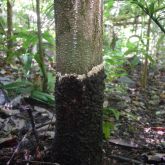Brown root rot

Brown root rot stocking with white leading edge, caused by Phellinus noxius
© Queensland Government

Flat, resupinate (upside-down) form of brown root rot fruiting body, which grows flush with the bark, buttress roots or on the underside of logs
© Queensland Government

Bracket form of brown root rot fruiting bodies, growing on hoop pine (Araucaria cunninghamii)
© Queensland Government
Brown root rot disease is caused by the fungus Phellinus noxius. The fungus attacks tree roots causing decay. This cuts off water and nutrient supply to the crown, causing tree death. Occurring naturally in rainforests, the disease has become a problem in forest plantations, fruit orchards and urban environments.
If you've found brown root rot (Phellinus noxius) on council land, contact your local council.
Scientific name
Description
- A 'stocking' with a white margin may form on roots or the tree trunk when actively growing, turning cinnamon-brown with age.
- Not all infected trees display a stocking.
- Fruiting bodies only develop after extended periods of rain:
- The resupinate (upside-down) form is flat and grows flush with the bark.
- Bracket fruiting bodies are leathery or woody and hard.
- Infected roots and wood exhibit a brown discolouration initially and later develop a soft, stringy white rot.
- In advanced stages of decay, a conspicuous network of brown lines forms between the bark and wood and the wood becomes light, dry, friable and honeycombed.
- See high-resolution images of brown root rot.
Distribution
East coast of Queensland to northern New South Wales. It is more prevalent in moist areas, or close to gullies or waterways.
Hosts
More than 200 species of native and introduced trees and shrubs including:
- palms
- figs (Ficus species)
- poinciana (Delonix regia)
- leopard tree (Libidibia ferrea)
- avocado (Persea americana)
- hoop pine (Araucaria cunninghamii)
- bunya pine (Araucaria bidwillii)
- spotted gums (Corymbia species)
- eucalypts (e.g. Eucalyptus camaldulensis, E. drepanophylla, E. grandis, E. pellita)
- Queensland maple (Flindersia brayleyana)
- silky oak (Grevillea robusta)
- Caribbean pine (Pinus caribaea var. hondurensis).
Damage
- In young trees, wilting is often followed by rapid death.
- In older trees, leaves gradually turn chlorotic (pale yellow and white), the crown thins and the tree eventually dies.
- Symptoms and the rate of development can vary considerably. It may take years for tree death to occur.
Biology
- Spreads by root-to-root contact and via air-borne basidiospores produced by fruiting bodies.
- Stumps of infected trees are sources of infection.
- Fragments of infected root tissue can remain in the soil for decades.
Control
- New plantings in infested sites may rapidly die if the source of the infection remains in place.
- Remove the entire infected tree and as many roots as possible, and:
- compost for at least 16 weeks, so the piles reach 75ºC, and turn over regularly
- sieve material greater than 18mm out of the final compost before using.
- Don't use infected trees for mulch without composting as described above.
- Planting non-susceptible annual crops in infected soil can assist in the breakdown of fragments of infected roots and wood.
- Installing root barriers around the infected site may reduce spreading, although this may not be effective as it is difficult to know how far the fungus has spread underground.
- Recent work has shown potential for biocontrol in the rhizosphere using species of the beneficial fungus Tricoderma.
Resources and research
- Ann, PJ, Chang, TT, Ko, WH. 2002. Phellinus noxius brown root rot of fruit and ornamental trees in Taiwan. Plant Disease, 86:820-826, viewed Aug 2023.
- Bolland, L. 1984. Phellinus noxius: cause of a significant root-rot in Queensland hoop pine plantations. Australian Forestry, 47:1, 2-10, viewed Aug 2023.
- Ribera, J, Tang, A, Schubert, M, Lam, R, Chu, L, Leung, M, Kwan, H, Bas, M, Schwarze, F. 2016. In-vitro evaluation of antagonistic Trichoderma strains for eradicating Phellinus noxius in colonised wood. Journal of Tropical Forest Science, 28(4):457-468, viewed Aug 2023.
- Wu, Z-C, Chan, Y-Y, Lai, Q-J, Lin, H-A, Tzean, S-S, Liou, R-F, Tsai, IJ, Chung, C-L. 2020. Soil is not a reservoir for Phellinus noxius. Phytopathology, 110(2):362-369, viewed Aug 2023.